This is a referential list of poisonous plants in that can be obtained in North America along with lethal doses and symptoms.
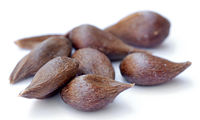 |
Malus Domestica/Apple |
The seeds are mildly poisonous, containing a small amount of amygdalin, a cyanogenic glycoside. The quantity contained in the seeds of a single apple is usually not enough to be dangerous to humans, but it is possible to ingest enough seeds to provide a fatal dose. |
Lethal Dose ~200 Seeds. |
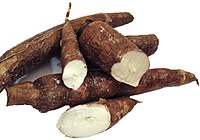 |
Manihot Esculenta/Cassava |
Roots and leaves contain two cyanogenic glycosides, linamarin and lotaustralin. These are decomposed by linamarase, a naturally occurring enzyme in cassava, liberating hydrogen cyanide. |
Lethal Dose 40mg |
 |
Solanum Tuberosum/Potato |
Potatoes contain toxic compounds known as glycoalkaloids, of which the most prevalent are solanine and chaconine. The toxin affects the nervous system, causing headaches, diarrhea and intense digestive disturbances, cramps, weakness and confusion, and in severe cases coma and death. Toxic compounds in the potato plant are generally concentrated in the green portions of the plant and in the fruits, and cultivated varieties contain smaller concentrations than wild plants. |
Lethal Dose 3 to 6 mg/kg of body weight |
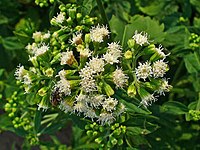 |
Ageratina Altissima/White Snakeroot |
All parts contain a toxic oil known as tremetol, which causes nausea and vomiting and is often fatal. Milk sickness is caused by drinking milk from cattle that have eaten white snakeroot, which can sicken or kill humans. |
|
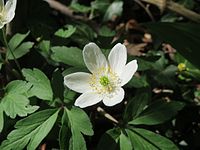 |
Anemone Nemorosa/Wood Anemone, Windflower, Thimbleweed |
The plant contains chemicals that are toxic to animals including humans. All parts of the plant contain protoanemonin, which can cause severe skin and gastrointestinal irritation, bitter taste and burning in the mouth and throat, mouth ulcers, nausea, vomiting, diarrhea, and hematemesis. |
|
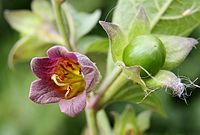 |
Atropa Belladonna/Deadly Nightshade, Belladonna, Devils Cherry, Dwale |
One of the most toxic plants found in the Western Hemisphere, all parts of the plant contain tropane alkaloids as do those of its equally deadly sister species A. baetica, A. pallidiflora and A. acuminata. The active agents are atropine, hyoscine (scopolamine), and hyoscyamine, which have anticholinergic properties. The symptoms of poisoning include dilated pupils, sensitivity to light, blurred vision, tachycardia, loss of balance, staggering, headache, rash, flushing, dry mouth and throat, slurred speech, urinary retention, constipation, confusion, hallucinations, delirium, and convulsions. The root of the plant is generally the most toxic part, though this can vary from one specimen to another. Ingestion of a single leaf of the plant can be fatal to an adult. The berries pose the greatest danger to children because they look attractive and have a somewhat sweet taste. The consumption of two to five berries by children and ten to twenty berries by adults can be lethal. Symptoms are caused by atropines disruption of the parasympathetic nervous system's ability to regulate involuntary activities such as sweating, breathing, and heart rate. The antidote for atropine poisoning is physostigmine or pilocarpine. In humans, its anticholinergic properties will cause the disruption of cognitive capacities like memory and learning. |
|
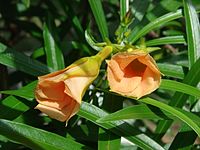 |
Cascabela Thevetia/Yellow Oleander |
All parts of the plant are toxic to most vertebrates as they contain cardiac glycosides. |
|
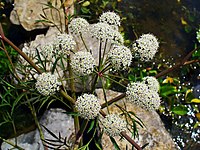 |
Daucus Carota/Wild Carrot |
It can be dangerously toxic to humans. Daucus carota has been reported to contain acetone, asarone, choline, ethanol, formic acid, HCN, isobutyric acid, limonene, malic acid, maltose, oxalic acid, palmitic acid, pyrrolidine, and quinic acid. When in contact with wet Daucus carota, skin irritation and vesication may occur. |
|
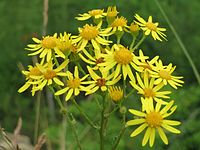 |
Jacobaea Vulgaris/Ragwort |
Contains many different alkaloids, including jacobine, jaconine, jacozine, otosenine, retrorsine, seneciphylline, senecionine, and senkirkine.Fresh ragwort due has a bitter taste, however it loses this taste when dried. The result, if sufficient quantity is consumed, can be irreversible cirrhosis of the liver. The danger is that the toxin can have a cumulative effect; the alkaloid does not actually accumulate in the liver but a breakdown product can damage DNA and progressively kills cells. Sensitive individuals can suffer from an allergic skin reaction after handling the plant because, like many members of the family Compositae, it contains sesquiterpine lactones, which are different from the pyrrolizidine alkaloids responsible for the toxic effects, which can cause compositae dermatitis. |
|
 |
Lantana Camara/Big Sage, Wild Sage, Tickberry |
The toxicity of L. camara to humans is undetermined. Other studies have found evidence which suggests that ingestion of L. camara fruit poses no risk to humans and are in fact edible when ripe. |
|
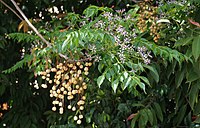 |
Melia Azedarach/Chinaberry, Cape Lilac, Syringa Berrytree |
Fruits are poisonous to humans if eaten in quantity. The toxins are neurotoxins and unidentified resins found mainly in the fruits. The first symptoms of poisoning appear a few hours after ingestion. They may include loss of appetite, vomiting, constipation or diarrhea, bloody faeces, stomach pain, pulmonary congestion, cardiac arrest, rigidity, lack of coordination and general weakness. Death may take place after about 24 hours. |
|
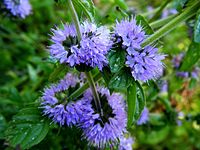 |
Mentha Pulegium/Pennyroyal, Pennyrile |
It is toxic to humans and has differing effects dependent on the volume and concentration ingested. The most concentrated and toxic form of the pennyroyal plant is pennyroyal oil. The oil contains 80% to 92% of cyclohexanone pulegone. Pulegone is the molecule in highest concentration, causes a variety of ailments in those who ingest it and is what causes the plant to have its peppermint flavor. Symptoms that may persist after ingesting a small dose (. 10 mL) of pennyroyal oil are nausea, vomiting, abdominal pain and dizziness. Larger volumes may result in multiorgan failure that could lead to death. |
|
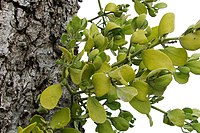 |
Phoradendron/American Mistletoe |
Mistletoe is a common hemiparasite of trees and shrubs. Toxicity varies by species, but all parts of the plant, especially the leaves and berries, contain an array of dangerous chemicals, including proteins called phoratoxins and toxic alkaloids. Symptoms are very similar to those produced by Viscum species and may include acute gastrointestinal discomfort, diarrhea, weak pulse and/or slow heart rate, and even seizures; it is rarely lethal to adult humans. |
|
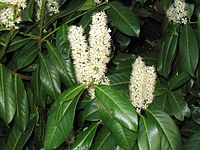 |
Prunus Laurocerasus/Cherry Laurel, Common Laurel, English Laurel |
Leaves, fruits, and seeds may cause severe discomfort to humans if ingested. The seeds contained within the cherries are poisonous like the rest of the plant, containing cyanogenic glycosides and amygdalin. This chemical composition is what gives the smell of almonds when the leaves are crushed. Laurel water, a distillation made from the plant, contains prussic acid and other compounds and is toxic. |
|
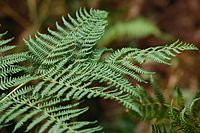 |
Pteridium Aquilinum/Bracken |
Carcinogenic to humans when ingested. The carcinogenic compound is ptaquiloside or PTQ, which can leach from the plant into the water supply, which may explain an increase in the incidence of gastric and oesophageal cancers in humans in bracken-rich areas. |
|
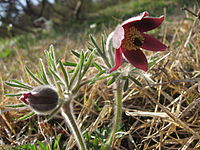 |
Pulsatilla Cernua/Pasque Flower, Wind Flower, Prairie Crocus, Meadow Anemone |
It is highly toxic, and produces cardiogenic toxins and oxytoxins which slow the heart in humans. Excess use can lead to diarrhea, vomiting and convulsions, hypotension and coma. |
|
 |
Quercus/Oak |
The leaves and acorns of oak species are poisonous in large amounts to humans. Poisoning is caused by the toxin tannic acid, which causes gastroenteritis, heart trouble, contact dermatitis and kidney damage. Symptoms of poisoning include lack of appetite, depression, constipation, diarrhea (which may contain blood), blood in urine, and colic. |
|
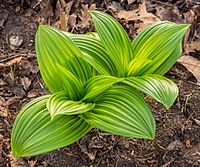 |
Veratrum/False Hellebore, Corn Lily |
Several species, containing highly toxic steroidal alkaloids that activate sodium ion channels and cause rapid cardiac failure and death if ingested. All parts of the plant are poisonous, with the root and rhizomes being the most toxic. Symptoms typically occur between 30 minutes and 4 hours after ingestion and include nausea and vomiting, abdominal pain, numbness, headache, sweating, muscle weakness, bradycardia, hypotension, cardiac arrhythmia, and seizures. Treatment for poisoning includes gastrointestinal decontamination with activated charcoal followed by supportive care including fluid replacement, antiemetics for persistent nausea and vomiting, atropine for treatment of bradycardia, and vasopressors for the treatment of hypotension. The toxic steroidal alkaloids are produced only when the plants are in active growth. |
Lethal Dose of ~0.6 grams or more. |
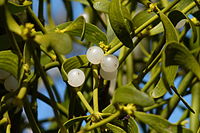 |
Viscum/European Mistletoe |
Mistletoe is a common hemiparasite of trees and shrubs. Toxicity varies by species, but all parts of the plant, especially the leaves and berries, contain an array of toxic chemicals, including several different viscotoxins, the alkaloid tyramine, and a ribosome-inactivating lectin called viscumin. Symptoms may include acute gastrointestinal discomfort, diarrhea, weak pulse and/or slow heart rate, and even seizures; it is rarely lethal to adult humans. |
|